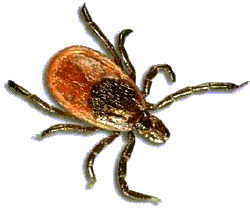|
I don't
know much about God or science, but find myself fascinated
by the current debate between intelligent design advocates
and evolutionists which is going on largely in Bible belt
states. The ID folks argue that some intervening intelligent
being creates life in its multiplicity of forms. The evolutionists
see a random and incessant process of slow changes producing
the most robust life forms, for that time and place, anyway.
I personally
believe that evolution is God's way of getting the results
he wants, and that he has a lot of fun doing it. But I
don't know for sure, and don't expect to.
Each
of us is awesome-a universe of billions of cells, awash
in oceans of bio-chemicals. One celled bacteria were quite
different, dull, or so I thought. I was raking leaves
at a home near Lake Wequaquet on a Saturday in April 1986.
On Monday, I felt very weak, and was at a doctor's by
Thursday. I had three reddish oval rashes on my chest,
but back then, physicians were looking for the now ''classic''
bulls eye rashes, so my Lyme Disease went undiagnosed.
I recovered
some on my own, without treatment, but had numerous relapses
over the next months. A year after the tick bite, I could
barely get out of bed. For the next eight years, I was
diagnosed, wrongly, with Chronic Fatigue Syndrome. In
1995, my Lyme was detected by an astute physician to whom
I went to for another problem. In the next years I received
substantial oral anti-biotic treatment. It lifted me out
of the zombie category, but I never will be genuinely
healthy. All the symptoms continue, less severe, and so
does the characteristic cycling. Now, depending on who
I ask, I have Chronic Lyme Disease with continuing infection
and an up-regulated immune system, or Chronic Fatigue
Syndrome, cause unknown , or Fibromyalga Syndrome, cause
unknown, or Post Lyme Syndrome, with an auto-immune etiology.
I became
curious about why medicine has so many different views
of the same set of symptoms.
The
dispute is over whether the causative agent of Lyme, the
spirochete bacterium Borrellia burgdorferi (Bb),
eludes both the immune system and significant courses
of antibiotic treatment, as some say, or if the host individual
experiences some sort of post-infectious syndrome. The
debate is heated, to say the least. Other spirochetes
cause syphilis and Relapsing Fever.
These
Bb little guys are only 20 microns, 20 millionths of a
meter long. They move with the aid of flagella, like little
worms with several sets of legs. They sequester in numerous
tissues, preferring neural tissue. Bb's locomotive capacities
allow it to move from through the skin and into the blood
stream, then into other parts of the body including the
brain.
Antigenic
variation is another tactic of Bb survival, and is a very
interesting phenomenon. Bacteria have Outer Surface Proteins
(OSPs), or antigens, to which the humoral immune system
develops antibodies which then attack and destroy the
bacterium. Antigenic variation gives the bacterium the
capacity to up-regulate (increase the number) or down
regulate specific OSPs, presenting a complex and varying
pattern to the immune system. A set of antibodies sufficient
to control the bacteria's spread at one point becomes
inadequate later.
Other
cards up Bb's sleeve are that, in the host, it can exist
in alternate forms, against which antibiotics are ineffective.
It has a cyst form, an egg- like mode from which the full
bacterium can later emerge.
Another
variation is a cell wall deficient form, which protected
it from antibiotics which attack cell walls. Bb also exchanges
DNA with others of its kind. This is the mechanism which
produces bacterial antibiotic resistance, which has become
a very serious medical problem.
Bacteria
have been shown to communicate bio-chemically with each
other. Bb may be one of those with this capacity, and
there is evidence that it produces neurotoxins.
So,
our agile little friend is quite gifted, a wondrous thing
really, not merely a brainless one cell simpleton. It
uses it complex strategies to survive and reproduce, as
do we all. As with the AIDs virus, it is small but not
fragile, and is no easy foe. It seems quite plausible
that it may be extremely hard to eradicate.
It was
Blake who asked that we see a world in a grain of sand.
I have come to understand that there is a stunning beauty
to Bb and other bacteria. Even the smallest living things,
including those which may harm or kill us as they live
out their lives, are gloriously endowed.
Whether
life is designed or evolves, or both, it displays a complexity
and magnificence to its many forms that speaks of more
than we can ever know.
Harold
Roy lives in Harwich.
|
